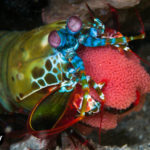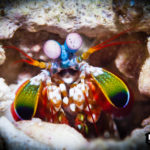The mantis shrimp is nothing short of fascinating, but how much do you know about this underwater creature that packs a devastating punch?
What makes the mantis shrimp special?
Scientists have identified over 400 species of mantis shrimp. Size-wise, they run the gamut from fairly small at 4 inches (10 cm) long up to 14 inches (35 cm). Many, such as the peacock mantis shrimp are brightly colored, and their eyes are quite unique and instantly recognizable.
Most species share a few distinctive and remarkable characteristics:
- Vision: The mantis shrimp has what science considers the most elaborate visual system in the animal world. Where the human eye has three types of color-receptive cones, the mantis shrimp possesses 16. Their eyes can also move independently from each other, which means they can process two different visual environments simultaneously. Scientists believe they can also see polarized light, as well as frequencies such as infrared and ultraviolet.
- Strength: The mantis shrimp has a pair of claws that are nothing short of lethal weapons. Depending on the species, they either use them to smash or spear their prey by impaling it on their claws. Their strength is such that with one blow they are able to crack a crab's shell, as well as mollusks. In fact, they punch their prey with the force of a bullet shot from a 22-caliber gun. And the speed of these deadly punches is such that it is almost impossible to see unless you film it in extreme slow motion. These small creatures are so strong that they're rarely kept in aquariums because one punch can shatter the glass — and they'll also feed on pretty much anything else in the same tank.
- Feeding: Unlike a lot of other mollusks, they hunt and kill prey in order to feed. Depending on the species, they eat fish, other mollusks, shells, and soft-bodied creatures.



Habitat and habits
You can see mantis shrimp popping in and out of their burrows both during the day and at night, but they can be hard to spot as they tend to hide in cavities or on the reef a lot. Some species dig a hole in the sand as an ambush for prey. They are long-lived, often over 20 years and can breed 20 to 30 times during their lifetime. Mantis shrimp also exhibit a range of mating behaviors, from living a solitary existence and only coming together to breed, to pairing up monogamously for up to 20 years. They also exhibit ritualized fighting and can come to recognize their neighbors on a reef based both on visual signs and smell.
Where can you find them?
Most species of mantis shrimp live in tropical and subtropical waters in the Indian and Pacific Oceans between eastern Africa and Hawaii, although they can live in more temperate water.
The post Marine Species: Mantis Shrimp appeared first on Scuba Diver Life.
from Scuba Diver Life https://ift.tt/2P1axc6
No comments:
Post a Comment